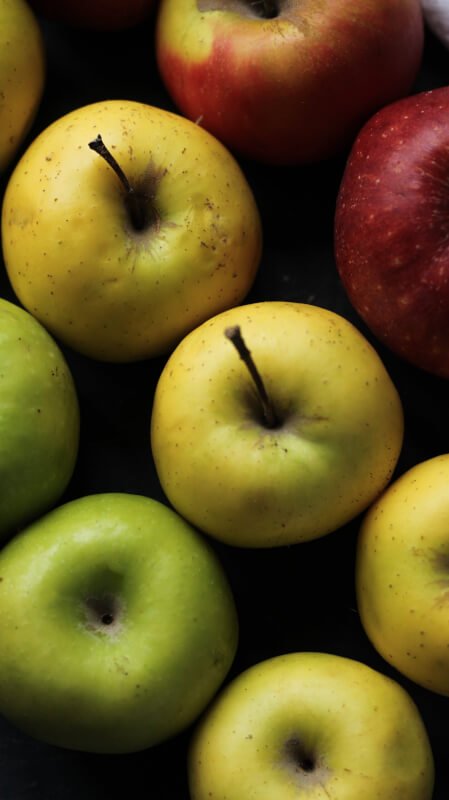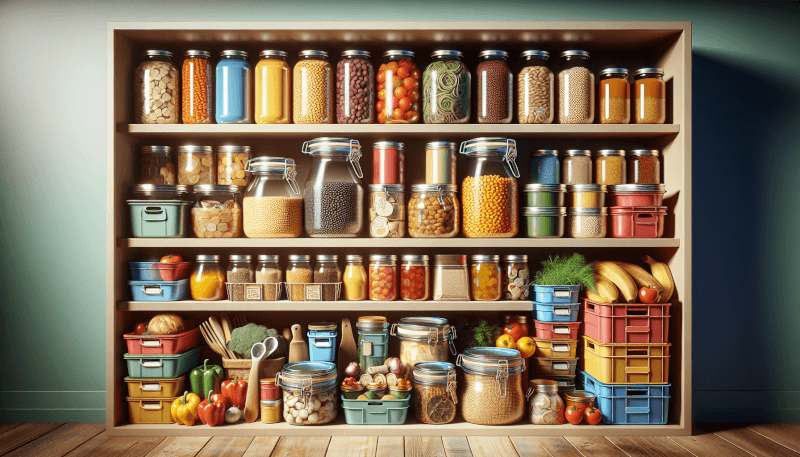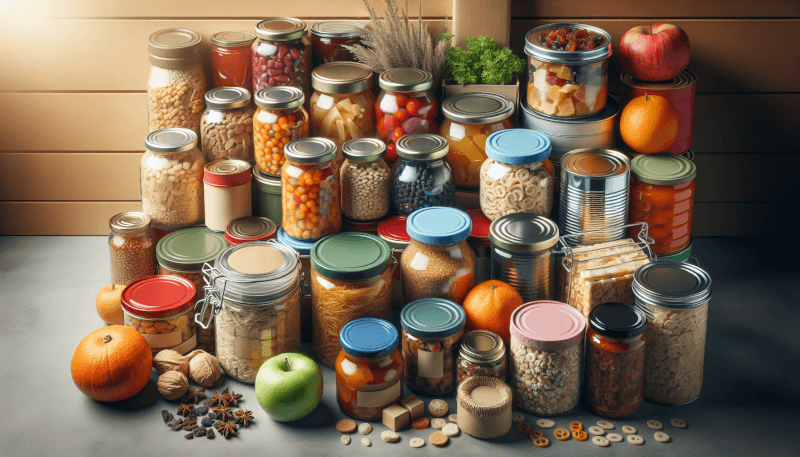Are you prepared for any unexpected emergencies or natural disasters? In times of crisis, having a reliable and well-stocked long-term food storage can be the key to ensuring your survival. Whether it’s a pandemic, severe weather conditions, or economic instability, being equipped with enough food to sustain yourself and your loved ones is crucial. This article explores the importance of long-term food storage for survival and provides valuable insights on how to build and maintain a proper food storage that will keep you well-nourished and secure in times of uncertainty.

Choosing the Right Foods for Long Term Storage
Considerations for Choosing Food
When it comes to choosing foods for long term storage, there are several important factors to consider. First and foremost, you should think about the nutritional value of the food. It’s essential to select foods that provide a balance of carbohydrates, proteins, and fats to ensure you are getting all the nutrients your body needs. Additionally, you should consider the taste and variety of the foods you select. It’s important to choose foods that you enjoy eating to maintain morale during challenging times. Lastly, you need to think about the shelf life of the food. Opt for foods that have a long shelf life to minimize the need for frequent restocking.
Best Foods for Long Term Storage
To make an informed decision about the best foods for long term storage, it’s crucial to consider their shelf life, nutritional content, and versatility. Some of the top foods for long term storage include:
- Rice: Rice has a long shelf life and is a great source of carbohydrates.
- Beans: Beans are packed with protein and fiber, making them an excellent choice.
- Pasta: Pasta is versatile and can be used in a variety of dishes.
- Canned Meats and Fish: Canned meats and fish provide a good source of protein and can last for years.
- Dried Fruits and Nuts: Dried fruits and nuts are high in essential nutrients and can provide a quick and healthy snack.
- Powdered Milk: Powdered milk can be used to make various dairy products and is an excellent source of calcium.
By including these foods in your long term storage plan, you can ensure a well-rounded and nutritious diet even during challenging times.
Foods to Avoid
While it’s important to focus on foods that are suitable for long term storage, there are also certain foods that are best to avoid. Some foods are not suitable for long term storage due to their perishable nature or lack of nutritional value. Here are some examples of foods to avoid when planning for long term storage:
- Fresh Fruits and Vegetables: Fresh fruits and vegetables have a short shelf life and are prone to spoilage.
- Dairy Products: Most dairy products, such as milk, cheese, and yogurt, have a limited shelf life and require proper refrigeration.
- Deli Meats: Deli meats are highly perishable and may harbor bacteria if not stored properly.
- Fried Foods: Fried foods tend to go rancid quickly and lose their taste and nutritional value.
- Foods with High Moisture Content: Foods with high moisture content, such as soups and stews, are prone to spoilage and can be challenging to store long term.
By avoiding these types of foods, you can ensure the longevity and quality of your long term food storage.

Proper Packaging and Storage Techniques
Choosing the Right Containers
Proper packaging is essential to maintain the quality and shelf life of your long term food storage. When selecting containers for storage, opt for those that are airtight and made of food-grade materials such as glass, plastic, or metal. Ensure that the containers are clean and dry before filling them with food. Transparent containers can be beneficial as they allow you to see the contents without opening them, minimizing exposure to air and contaminants.
Using Oxygen Absorbers
To further extend the shelf life of your long term food storage, consider using oxygen absorbers. Oxygen absorbers are small packets that absorb any remaining oxygen inside the storage containers, preventing spoilage and the growth of mold and bacteria. They are easy to use – simply place the absorber packet inside the container before sealing it. Oxygen absorbers are especially effective for dry foods like rice, beans, and powdered milk.
Temperature and Moisture Control
Proper temperature and moisture control are crucial for maintaining the quality and longevity of your stored food. Aim to store your food in a cool, dry place away from direct sunlight, as heat and light can speed up the deterioration process. It’s recommended to maintain a temperature of around 50 to 70 degrees Fahrenheit (10 to 21 degrees Celsius) for optimal food storage conditions. Additionally, ensure that the storage area is free from excessive moisture and humidity, as this can lead to the growth of mold and mildew.

Popular Methods of Long Term Food Storage
Canning
Canning is one of the oldest and most popular methods of long term food storage. It involves placing food in jars, sealing them, and heating them to kill any bacteria or microorganisms that could cause spoilage. Canned foods can last several years if stored in a cool and dark place. Fruits, vegetables, soups, and sauces are commonly canned.
Dehydrating
Dehydrating food involves removing its moisture content to prevent spoilage. It can be done using a food dehydrator, an oven, or even by air-drying in a dry and warm environment. Dehydrated foods are lightweight, compact, and have a long shelf life. Fruits, vegetables, herbs, and jerky are popular choices for dehydration.
Freezing
Freezing is a common method of preserving food in the short term, but it can also be used for long term storage. By freezing foods at or below 0 degrees Fahrenheit (-18 degrees Celsius), you can extend their shelf life for many months or even years. Proper packaging, such as vacuum sealing or using freezer-safe containers, is important to prevent freezer burn and maintain the quality of the food.
Vacuum Sealing
Vacuum sealing involves removing air from the packaging before sealing it, creating a vacuum seal that helps prolong the shelf life of the food. It is an effective method for preserving a wide range of foods, including meats, fruits, vegetables, and even leftovers. Vacuum-sealed foods can last three to five times longer than conventionally packaged foods.
Mylar Bags
Mylar bags are a popular choice for long term food storage due to their durability and ability to block light, moisture, and oxygen. These bags, made of metallized polyester film, provide an extra layer of protection for your food. Additionally, they can be heat-sealed to create an airtight and secure storage environment. Mylar bags are often used in conjunction with oxygen absorbers to maximize the shelf life of the stored food.

Rotating and Managing Stored Food
Rotating Food Supplies
To ensure that the food in your long term storage remains fresh and consumable, it’s important to practice a system of rotation. This means using the oldest stored food first and restocking with fresh supplies, ensuring that your stockpile remains up to date. By implementing a first in, first out (FIFO) system, you can prevent food from expiring and minimize waste.
Monitoring Food Quality
Regularly monitoring the quality of your stored food is essential to ensure its safety and suitability for consumption. Inspect the packaging for any signs of damage, such as dents, bulging, or leaks, as these may indicate spoilage or contamination. Additionally, check for any changes in color, texture, or smell. If you notice any signs of spoilage, it’s best to discard the food to avoid potential health risks.
Managing Inventory
Managing your stored food inventory is crucial for effective long term food storage. Keep a comprehensive inventory of the foods you have in stock, including quantities and expiration dates. Regularly update the inventory as you consume or replace items. This will help you stay organized, plan future meals, and avoid any surprises regarding expired or inadequate supplies.

Calculating and Stocking a Long Term Food Supply
Determining Your Caloric Needs
Before stocking your long term food supply, it’s essential to determine your caloric needs. The number of calories you require each day will largely depend on factors such as age, gender, activity level, and overall health. Consulting a nutritionist or using online caloric calculators can be helpful in estimating your daily caloric requirements. Once you have determined this number, you can select and store enough food to meet your needs for an extended period.
Estimating Food Shelf Life
Estimating the shelf life of your stored food is crucial for maintaining its quality and safety. Consult the packaging or conduct research to understand the average shelf life of the foods you have selected. Keep in mind that optimal packaging and storage conditions can often extend the shelf life beyond the manufacturer’s estimate. Additionally, rotate and consume the oldest foods first to ensure you are always consuming the freshest supplies.
Creating a Comprehensive Inventory
Creating a comprehensive inventory of your long term food supply is essential for efficient management and planning. Organize your inventory by food type, quantity, and expiration date. Consider using spreadsheet software or specialized food storage inventory apps to keep your inventory easily accessible and up to date. With a well-maintained inventory, you can avoid expiration and shortages, and ensure your long term food supply remains sufficient for your needs.
In conclusion, choosing the right foods for long term storage, properly packaging and storing them, utilizing popular methods of long term food storage, effectively managing and rotating your stored food, and calculating and stocking an adequate supply are all essential aspects of creating a comprehensive long term food storage plan. By following these guidelines, you can ensure that you and your loved ones are prepared for any situation that may arise and have a stable and nutritious food source to rely on. Stay prepared, stay safe, and stay well-fed!


